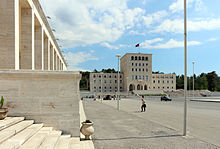Mother Teresa Square
The Mother Teresa Square ( Albanian Sheshi Nënë Tereza ; pronunciation: [ʃɛˌʃi nəˌn (ə) ˌtɛɾɛˌza] ) is a place in the south of the center of Tirana , capital of Albania . It forms the southern end of the Bulevardi Dëshmorët e Kombit , the central axis of the city. At its southwest corner it is connected to Rruga Lekë Dukagjini and at its southeast corner with Italia-Platz . It is located 110 meters above sea level.
Mother Teresa Square is one of the most important squares in the Albanian capital , along with Skanderbeg Square . Citizen protests are often held on it, and in some cases it also serves as the start or end point of a protest march that leads across the northern boulevard to Skanderbeg Square. The square has not only a political and social significance, but is also a center of culture and education in Albania: with the University of Tirana , the Polytechnic University of Tirana , the University of the Arts Tirana , the National Archaeological Museum and the Center for Albanological Studies have significant Institutions of culture, research and science have their headquarters on Mutter-Teresa-Platz.
The rectangular square is open to traffic. At the edges it is lined with chargeable parking spaces. In the middle there is now a slightly raised, also rectangular platform for passers-by. A few years ago there was a multi-level well at this point. Under the new mayor Erion Veliaj , the square was closed to traffic every evening in summer 2015 and used as a pedestrian zone and open space for cyclists. A Christmas market was held on the square in December 2015 .
The square is around 130 meters long and 95 meters wide. The Tirana University of the Arts is on the western length, while the National Archaeological Museum is located on the eastern length. A colonnade connects the two building units of the museum and forms a passage from Mutter-Teresa-Platz to the neighboring Italia-Platz to the east , on the opposite side of which is the Qemal-Stafa-Stadion . However, the square is dominated by the main building of the Polytechnic University. It is located on the southern breadth of the square as an extension of the boulevard and, also accessible via stairs, is a little higher than the other buildings. The square is oriented to the north-northwest towards the boulevard. Behind the parking lots and sidewalks on all three other sides stone stairs lead up to the three prominent buildings of the square.
The Mutter-Teresa-Platz, surrounded by colonnades and magnificent buildings, and the boulevard that joins it were laid out as a unit after the Italians occupied Albania in the spring of 1939. The Italian fascists named the boulevard and the square Viale del Impero and Piazza del Littorio ("Square of the Lictor "). The architect in charge was Gherardo Bosio . The dominant building was built from 1940 as the Casa di Fascio ; In 1957 the first university in Albania was founded in the former seat of the fascists. The building of the art university (formerly Akademia e Arteve ) is housed in the Opera Dopolavoro Albanese theater, built in 1940 . The opposite building was then built as Palazzo della Gioventù del Littorio Albanese , the palace of the fascist youth organization of Albania. Like the entire complex, these buildings were also designed by architect Gherardo Bosio. The Prokopios Church , the first Orthodox church in Tirana from the 1780s, stood in front of the magnificent buildings in this area .
The square is named after Mother Teresa , in her honor there is a small statue on the side of the University of the Arts.
literature
- Riccardo Renzi: La Casa del Fascio di Tirana . In: Simone Gismondi, Silvia Frassi (eds.): Architetti e ingegneri italiani in Albania . Edifir, Florence 2012, ISBN 978-88-7970-583-7 , pp. 89-96 .
Web links
Individual evidence
- ↑ Protesta e opozitës, policia publikon Masat e sigurisë. Retrieved January 3, 2016 .
- ↑ See older photographs.
- ↑ Një pasdite në sheshin "Nënë Tereza" pa makina. In: Historia ime. May 20, 2015, accessed January 3, 2016 (Albanian).
- ↑ Bashkia e Tiranës ndez dritat e pemës së Vitit të Ri dhe zbukurimeve të vendosura në të gjithë qytetin. In: Bashkia Tirana. December 6, 2015, accessed January 3, 2016 (Albanian).
- ↑ Besnik Aliaj, Keida Lulo, Genc Myftiu: Tirana - The Challenge of Urban Development . Tirana 2003, ISBN 99927-880-0-3 .
- ^ Armand Vokshi: Gherardo Bosio: Le oppere in Albania . In: Simone Gismondi, Silvia Frassi (eds.): Architetti e ingegneri italiani in Albania . Edifir, Florence 2012, ISBN 978-88-7970-583-7 , pp. 81-88 .
- ↑ Gazmend Bakiu: Tirana e vjetër . Mediaprint, Tirana 2013, ISBN 978-9928-08101-8 , Kisha e Shën Prokopit, p. 97 f .
Coordinates: 41 ° 19 ′ 4 ″ N , 19 ° 49 ′ 16 ″ E


